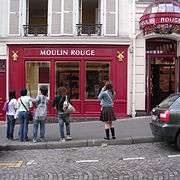Paris syndrome

Paris syndrome (French: Syndrome de Paris, Japanese: パリ症候群, Pari shōkōgun) is a transient mental disorder exhibited by some individuals when visiting or going on vacation to Paris, as a result of extreme shock derived from their discovery that Paris is not what they had expected it to be. The syndrome is characterized by a number of psychiatric symptoms such as acute delusional states, hallucinations, feelings of persecution (perceptions of being a victim of prejudice, aggression, or hostility from others), derealization, depersonalization, anxiety, and also psychosomatic manifestations such as dizziness, tachycardia, sweating, and others, such as vomiting.[1] Similar syndromes include Jerusalem syndrome and Stendhal syndrome. The condition is commonly viewed as a severe form of culture shock. It is particularly noted among Japanese travelers. It is not listed as a recognised condition in the Diagnostic and Statistical Manual of Mental Disorders.
History
Professor Hiroaki Ota, a Japanese psychiatrist working in France, is credited as the first person to diagnose the condition in 1986.[2] However, later work by Youcef Mahmoudia, physician with the hospital Hôtel-Dieu de Paris, indicates that Paris syndrome is "a manifestation of psychopathology related to the voyage, rather than a syndrome of the traveller".[3] He theorized that the excitement resulting from visiting Paris causes the heart to accelerate, causing giddiness and shortness of breath, which results in hallucinations in the manner similar to the Stendhal syndrome described by Italian psychiatrist Graziella Magherini in her book La sindrome di Stendhal.[4]
Susceptibility

Japanese visitors are observed to be especially susceptible.[2][5] It was first noted in Nervure, the French journal of psychiatry, in 2004.[6] From the estimated six million yearly visitors, the number of reported cases is not large: according to an administrator at the Japanese embassy in France, around 20 Japanese tourists a year are affected by the syndrome.[7]
Mario Renoux, the president of the Franco-Japanese Medical Association, states in Libération': "Des Japonais entre mal du pays et mal de Paris" ("The Japanese are caught between homesickness and Paris sickness", 13 December 2004) and that Japanese magazines are primarily responsible for creating this syndrome. Renoux indicates that Japanese media, magazines in particular, often depict Paris as a place where most people on the street look like "stick-thin" models and most women dress in high fashion brands such as Louis Vuitton.[8]
See also
Bibliography
- Notes
- ↑ Wyatt, Caroline (2009). "Mastering French manners, the hard way". BBC News. Retrieved 4 November 2009.
- 1 2 Wyatt, Caroline (20 December 2006). "'Paris Syndrome' strikes Japanese". BBC News. Retrieved 4 November 2009.
- ↑ Xaillé, Anne (21 November 2002). "Voyage pathologique: Voyager rend-il fou ? (Eng: Travel pathological: Traveling makes you crazy?)" (in French). The organization of the AP-HP. Retrieved 5 November 2009.
- ↑ Magherini, Graziella. La sindrome di Stendhal (in Italian) (1995 ed.). Ponte alle Grazie. ISBN 88-7928-308-1. - Total pages: 219
- ↑ Tamami, Katada (1998). "Reflections on a case of Paris syndrome". Journal of the Nissei Hospital. Science Links Japan. 26 (2): 127–132. ISSN 0301-2581. Archived from the original on 30 October 2013. Retrieved 5 November 2009.
- ↑ Viala, A.; H. Ota; M.N. Vacheron; P. Martin; F. Caroli (June 2004). "Japanese pathological trip to Paris: an original model of cross-cultural management [in French]". Nervure Supplément. 17 (5): 31–34. Retrieved 11 July 2016.
- ↑ Chrisafis, Angelique (25 October 2006). "Paris syndrome hits Japanese". London: The Guardian. Retrieved 4 November 2009.
- ↑ Levy, Audrey. "Des Japonais entre mal du pays et mal de Paris". Libération (in French). Retrieved 25 November 2014.
- References
- Viala, A.; H. Ota; M.N. Vacheron; P. Martin; F. Caroli (2004). "Les Japonais en voyage pathologique à Paris : un modèle original de prise en charge transculturelle". Nervure Supplément. 17: 31–34. Retrieved 4 November 2009.
